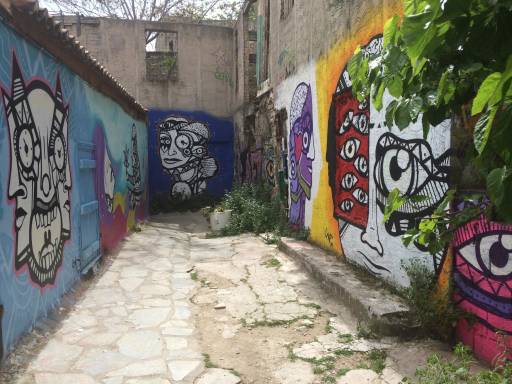Over twenty years ago my grandmother and aunt traveled through Europe and Africa on a tour of ancient civilizations. I read about their travels and appreciated learning about the things they saw, and wished to one day see them myself. In April 2015 this wish came true when I visited Athens, Greece for the first time.
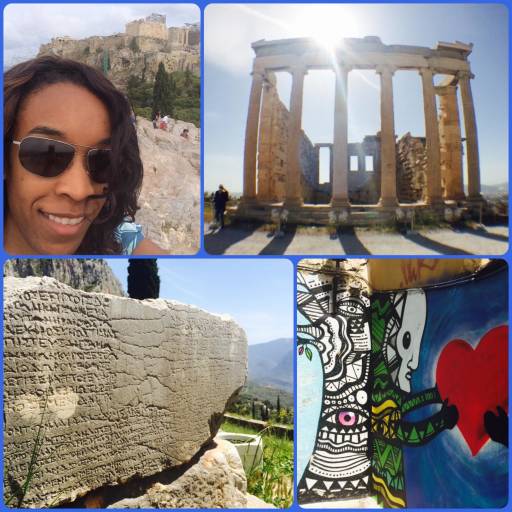
Planning The Trip
Although I was inspired by my grandmother’s travel essay, the reason I went on this trip was really for one simple reason—a sale! EasyJet, a discount European airline, had a sale slashing their already low prices even lower. I chose Athens because I knew I would be traveling alone and thought it would be a destination where I could enjoy the sites and activities even without a travel companion.
In the weeks leading up to the trip I told people that I would be visiting Athens. The main responses were always somewhere along the lines of ‘Athens!? You should go to the islands instead!’ or ‘4 days is too long, you can see it all in 1’ or simply, ‘that place is a dumphole.’ Not exactly the most inspiring response! But the trip was booked and I planned to make the best of it.
Arrival Into Athens
I arrived into Athens Eleftherios Venizelos International Airport on a Sunny Sunday morning and made my way into the city. There is a metro train stop just across the street from the airport, and Athens offers a 3-day tourist pass with unlimited public transport and a round trip airport journey, so I bought this and boarded the train.
On arriving into the city center, I had to find my way to the apartment I would stay in over the next three nights. While it was only a 10-minute walk from the Acropolis metro station, finding the way for the first time can be difficult as you never know exactly where you are when you come from underground, the center is very loud and busy, and you don’t want to draw attention to yourself as a tourist by holding a map and looking confused. I picked a direction and stuck with it.
This walk was not a pleasant one to say the least: I had to cross giant roads with cars and mopeds speeding by; the crossing lights were short, and the traffic lights only seemed to be a suggestion to the vehicles on the road. After this I walked up a steep hill (thank goodness I only had a backpack!) on a road with broken sidewalks, empty lots, clothing and trash in the street, and not a person in sight. I passed through two more of these frantic roads and one more dubious street before finally arriving at my destination. By this time I was thinking, ‘everyone was right about this place, what have I gotten myself into!’
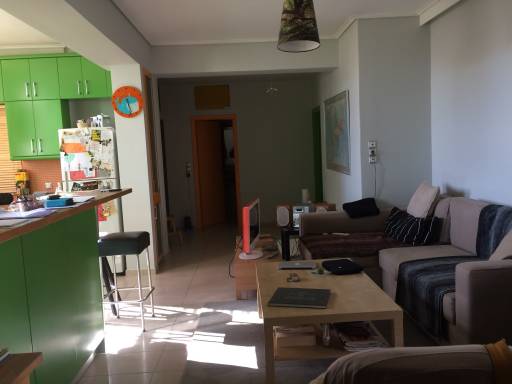
Finally in the comfort of a lovely apartment in the Mets (Μετσ) neighborhood, I met my host Kalliopi, whose spare room would be my home for the next few days. I had booked the room on Airbnb.com and was happy to find that the apartment matched the pictures and description I saw online. Kalliopi gave me some tips about places to go and see, but I was eager to get out for a bit and explore the city.
First Walk Around Athens
During my journey from the airport, I received an email telling me that the Athens walking tour I had booked for the next morning had been cancelled. I had planned this activity for my first morning as an orientation to the city, so this news was disappointing. My main goal on this Sunday afternoon walk was to find something to replace the tour.
I also wanted to find a better route to walk to and from the apartment, and thankfully I found it straight away. The Mets neighborhood is just under the Acropolis, adjacent to a large green space which contains Hadrian’s Arch and the Temple of Olympian Zeus. Walking along this park was a lot less frantic and provided quicker access to the sites.
Circling around through the Plaka Neighborhood and up to Syntagma Square, I was surprised to find there was no tourist information available in these high-traffic hotspots, and the offices that came up in a Google search had all been closed permanently or didn’t seem to exist where they should have been at all. While in other cities it’s often possible to find a central location to find out basic information, in Athens it just didn’t exist! This was another source of stress, and in my mind, it strengthened the opinions everyone had offered before I traveled. Finally I found one open travel agency and booked an all-day tour to visit Delphi the next day.
With this successfully booked, I was free to wander the city. I had read about some of the main parts of the city, Plaka and Syntagma Square being two of them. I had also heard about a small hidden village under the Acropolis called Anafiotika (Αναφοωτικα), where it feels like you’re on a Greek island; Kalliopi had also recommended Psyrri (Ψυρρη) and Exarchia (Εξαρχεια) as really cool neighborhoods worth checking out.
I started my walk through Plaka. This neighborhood is below the Acropolis near Hadrian’s Arch, and it stretches all the way down to Monastiraki Square, another Athens central hub. Along the way the streets are lined with shops of souvenirs, handcrafts, and restaurants, and many of these had people outside asking passersby to come in and have a look. The streets were narrow and seemed pedestrianized, but time after time a moped or even taxi would race through and everyone on foot had to stand (or squeeze) to the side to let them pass.
Not necessarily interested in the touristy shops and in search of Anafiotika, I turned off of a main street to walk up some stairs to a quieter road. While the driving roads seem to run across the hill, the main way up or down is staircases or narrow alleyways. Passing through the streets I found myself directly under the Acropolis on Aeropagus Hill, with a magnificent view of the city. From here one could see just how vast and packed in Athens is, stretching all the way to the base of Pendeli Mountain, and only broken by geological features where it would be impractical to build. Aeropagus Hill also has a great view of the Acropolis from below the site’s main entrance. The hill itself was dotted with tourists, families, and couples all taking in the view and perhaps awaiting a scenic sunset; everyone was relaxed and simply enjoying the place they were in. Finally, a glimpse of the Athens I was hoping to find!

Heading back down the hill I passed lots of ruins and archeological sites before coming across Adrianou Street (Αδριανου), another pedestrian road with shops and restaurants, although this one seemed to have a lot more Greek people around, mixed in with the tourists. Coming to the end, I found that Ermou Street (Ερμου)—another shopping road I’d read about before arriving—was close by. This end, by Thissio Station (θησειο), is not the main shopping road. Instead the narrow, dirty sidewalks were lined with garage doors, open and overflowing with knickknacks and antiques. Furniture, home decorations, old record players—it looked like you could find some great things in there with a bit of time, luck, and haggling.
From here I reached Monastiraki Square and remembered that the Athens Central Market would be close by, just up Athinas Street (Αθηναζ). Unfortunately the market was closed but I carried on walking up to Kotzia Square (Κοτζια) and found a beautiful open-air daily flower market with pots starting as low as 1 euro.
Athinas Street runs through the Psyrri neighborhood so I backtracked to take more of it in, stopping along the way for a “frappé,” a coffee drink favored by the Greeks which seemed to be in everyone’s hands everywhere I went! It’s sort of like an iced coffee but covered in a creamy coffee/milk foam and with white cream layered on top; the best part is the price—1 euro pretty much anywhere you go!
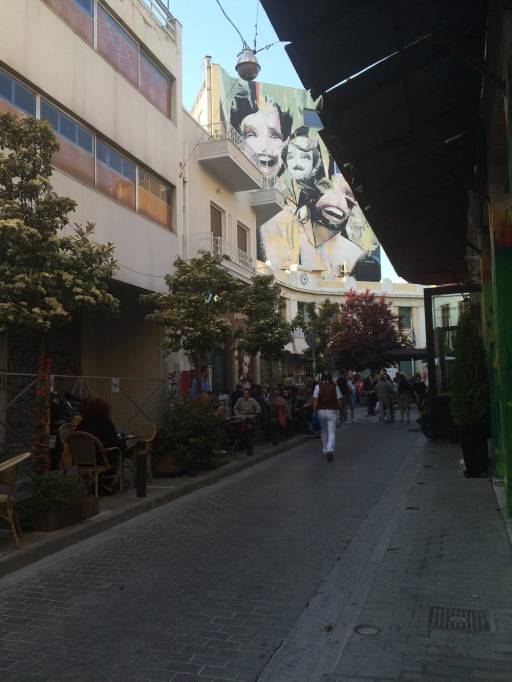
With a frappé in hand I finally wandered through the neighborhood streets of Psyrri. This is definitely a derelict area. Most of the buildings are run down if not literally crumbling, and any businesses that were once here are now long closed. However while most of Athens is covered in graffiti, in Psyrri it personifies the term ‘street art,’ and many of the walls are covered in giant murals of bright colors. Tucked within the neighborhood is a small cluster of streets where restaurants and businesses continue to thrive, and here I had dinner at a wonderful restaurant called Lithos (Λιθοσ). Such an amazing meal after a long day of travel and walking! When it comes to vegetables, bread, and olive oil, the Greeks really have it down. I ended the meal with a Greek orange sponge cake dessert called ravani (ραβανι) which, served with vanilla ice cream, was the perfect way to end the day.
Walking back through Psyrri to go back to the apartment, the streets were teeming with people and the restaurants and nightclubs were just getting started. It was easy to see the vibrancy of this neighborhood as it came to life and I understood its charm. By the end of the evening, Athens had shown me why half of all Greeks living in Greece choose to live in this city, and that despite its outward appearance, Athens is not a ‘dumphole’ after all.
Tour of Delphi
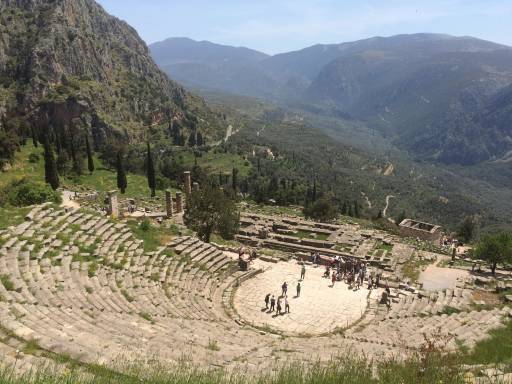
Delphi is an archeological site located about 75 miles outside of Athens with most of its structures dating back to the 6th century BC. In Greek mythology the area was considered to be the center of the universe, and so throughout the centuries it was a place to worship, provide offerings to the gods, and to show off one’s wealth and prosperity by donating elaborate temples and statues. Delphi was also a pilgrimage destination for powerful rulers and citizens to seek answers directly from the god Apollo; a great oracle priestess called a Pythia resided on the mountain and was the single earthly human who could supposedly consult with Apollo directly.
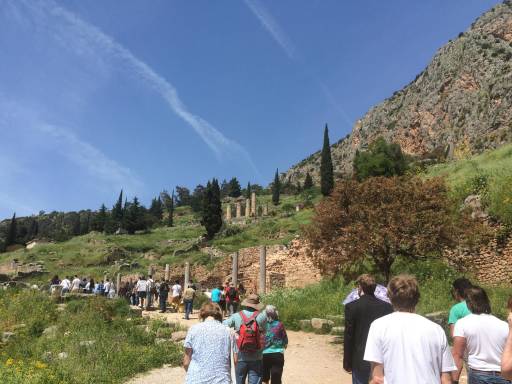
Delphi is situated in the cradle of Mount Parnassus, and as the site fell out of use, earthquake and mudslides buried a vast majority of the area. The modern city of Delphi was even built on top of the ancient ruins; in the 1890s archeologists discovered the antiquities beneath the earth, and the modern city of Delphi was moved a few miles away to enable further excavations. Today, evidence of the temples and buildings has been uncovered for us to admire.
Walking around the site during the guided tour was chaotic, with a lot of visitors led by tour guides shouting in many different languages, all trying to get around each other on the somewhat narrow walking paths. But despite the chaos, the visit was still a great one, aided by the bright blue sky and swathes of wild flowers growing throughout the ancient ruins.
There were also several interesting highlights amongst the ruins. One such place was the wall of the ancient stoa; in ancient times if a slave was to be freed, he had to carve the reasoning for his freedom as thanks to Apollo in the walls of the stoa, and many of these carvings can still be viewed here. Another highlight was the ancient stadium, all the way up the hill towards the back of the site. Every 4 years from 586 BC, Delphi was the site of the Pythian Games, a precursor to the modern Olympics, and thousands would travel to Delphi to watch. As a big fan of the Olympics, I found it interesting to see one of the sites where it all got started thousands of years ago.

Next to the ancient site of Delphi sits the archeological museum where many of the more fragile discoveries from the excavations are preserved. Since the statues and offerings brought to Delphi were dedicated to the God Apollo, they were often massive and elaborate, and it’s incredible how some of them have survived over the centuries—in some cases they even still maintain evidence of the original colored paints.
Some of the most impressive items on display included the giant sphinx which sat on top of a column in ancient Delphi, intricately carved columns, and even an musical score for “The Song of Athens,” fully marked with ancient musical notations. The museum’s crowning jewel is a life-size bronze statue of a Pythian games athletic champion, which has been preserved almost perfectly over the years even down to the individual bronze eyelashes. Since bronze was a valuable metal and it was regularly melted down to make weapons in times of battle, the fact that this statue still exists for us to appreciate is a great achievement in history.
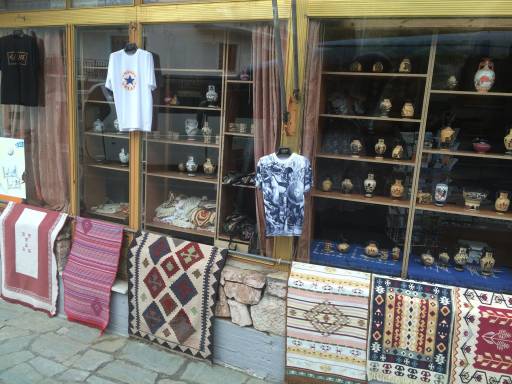
From the ancient site of Delphi we went on to have lunch and had a brief stop in the hillside town of Arachova (Αραχοβα). While I wish I had some interesting things to recount about these places, unfortunately the tour I was on did not make this possible. For lunch we passed through the modern city of Delphi to go to an isolated restaurant with ridiculous prices, and in Arachova we only had a 15-minute stop, conveniently located outside a large rug & souvenir shop and a good distance from the center of the town. Both modern Delphi and Arachova looked like very interesting little villages and I would be happy to return to further explore them in the future.
A Walking Tour of Athens
The next morning I was grateful to be able to go on the free walking tour, rescheduled from Monday’s cancellation. The tour started in Syntagma Square and was led by Trevor, a British expat who has been living in Greece and Athens for around 15 years. It was a small group; I was joined by another solo traveler from France, and a family (mom, dad, and two pre-teen daughters) from India who live in Zurich.
Our walk started walking down a street off the main square where we saw great examples of Athens’ modern architectural evolution. The city used to be filled with rows of neoclassical buildings where extended families of sometimes 4 generations all lived under one roof. In the 1960s, property developers came to many of these homeowners and offered to buy the buildings in exchange for a lot of money and two free apartments—an offer which was difficult to refuse. As a result, many of the neoclassical buildings were torn down to build high-rise residential towers, and now much of the historical center alternates between beautifully restored neoclassical mansions and the imposing concrete towers.
Another thing that is very evident walking around the city is its economic fall. Shop after shop, building after building, you see empty storefronts and condemned or half-built structures. Trevor explained that many of the closures in the center are quite recent—a result of the 2008 economic crash which Greece is just beginning to recover from.
Despite the disrepair and inconsistent architecture, one thing has remained constant—the churches. Every few blocks we came across small local churches which were still in use on the sites they had been on for probably hundreds of years. In one case, a modern office building was even built around the church, so it sits under the eaves of the extended base of the building.
On the tour we also passed by ancient ruins—the Roman agora, Hadrian’s Library, the ancient agora, and of course just below the Acropolis. Athens really is a city with its ancient history on full display, and for some of the sites which require an entry ticket, you can still see the majority of the attraction just walking down the sidewalk.
Winding up through Anafiotika, we came just below the eastern side of the Acropolis, at the base of the cliff side. From here it’s possible to see just how huge the Greek flag that flies here truly is, and we learned about the time during World War II when the Nazi flag flew here in its place. During the German occupation, an Evzone soldier (one of Greece’s most elite forces) was ordered to take down the Greek flag and replace it with the Nazi flag. He took down his flag ceremoniously but then rather than handing it over to the Germans, he wrapped himself in it and jumped off of the cliff to his death. This soldier became a Greek hero, and the site bears special reverence in the city now that the Greek flag has been restored.
From the base of the Acropolis we wound back down to Plaka and over to Hadrian’s Arch, which was once an entry to the planned new city of Athens, and viewed the remnants of the Temple of Olympian Zeus which, if it still stood, would even dwarf the Parthenon in size. Next to these sites lie the National Gardens—great for a sunny stroll through the flowering trees and covered, blooming walkways towards Syntagma Square. Our tour ended just in time to watch the Evzones soldiers complete the ceremonial changing of the guard in front of the Tomb of the Unknown Soldier.
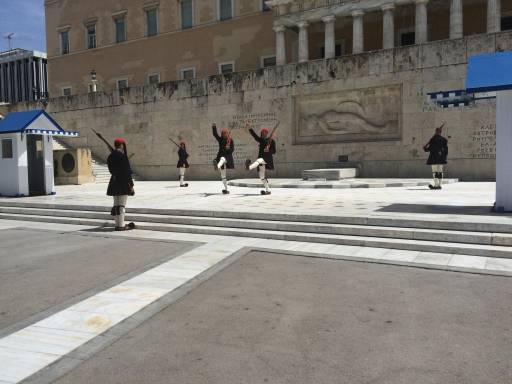
The Acropolis and Its Museum
Next on the docket was finally ascending Athens’ crown jewel piece, the Acropolis. The Acropolis is one of the highest hilltops in Athens, and is the mythological center of the genesis of the city. Story goes that the earliest settlers had to choose which of the gods to dedicate their new city to, and the choice was between Poseidon, god of the sea, and Athena, goddess of wisdom. In a contest atop the Acropolis, Poseidon struck the earth with his trident and a natural spring bubbled water from the ground. In turn, Athena struck the earth and an olive tree sprouted to full size. The settlers chose in favor of Athena’s gift, named their city after her, and built a temple in her honor where the olive tree grew. And so Athens and the Acropolis came to be.
The site itself has evidence of humans dating all the way back to the 5th millennium BC, but the ruins we see today date back to the 5th century BC. The Parthenon—a massive temple built to house a decadent statue of Athena—was the main masterpiece atop the Acropolis, and it was surrounded by a number of other temples, theatres, and monuments all built to honor the gods. Over the centuries and throughout different rulers and occupations many of the buildings had different uses or were deconstructed, repurposed, destroyed, or rebuilt. Archeologists have been researching the site for over a hundred years now, and many of their findings are on display in the newly opened Acropolis Museum.

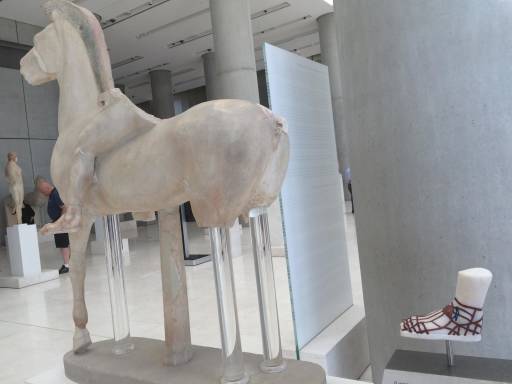
This was my first stop in taking in the Acropolis, and it is an attraction I would definitely recommend to any visitors of Athens! It’s a modern and incredibly well-developed museum, easy to walk through and learn from as you go. One of my favorite highlights was an area where they show how color was such a big part of the decoration of statues and buildings in ancient times. While now we can only see a faint red or gray shading, ancient Greeks used bright and vivid colors alongside metallic ornamentation to decorate their monuments. This part of the exhibition shows both how they made the colors and also gives great comparisons of how the statues would have looked in their full glory.
The masterpiece of the Acropolis Museum is its top floor life-size installation of the frieze, metopes, and pediments of the Parthenon. The frieze and metopes consist of huge slabs of marble, carved in relief to depict various scenes, which were installed all around the top of the ancient temple; two pediments of even larger marble sculptures were placed above the temple entries at either of the long ends. In the museum in a massive glass space in view of the actual Parthenon, you can walk all the way around as though you were walking around the Parthenon itself, to view what’s left of the original marble carvings. If the original items have been destroyed over the years, that spot is empty, and if only a fraction of the original sculpture still exists, they have done their best to recreate what’s missing to give us an idea of the original work.
Most controversial in this space are the modern recreations of a number of works whose originals are actually housed in the British Museum in London. In the early 1800s when Athens was occupied and controlled by the Ottoman Empire, the Turkish rulers permitted a large number of the best-preserved sculptures and carvings to be taken away by the British, and these were eventually sold to the British Museum. Since the 1980s, the Greek government has made many efforts to have the sculptures returned, and for many years the British argued that there was no adequate place to put them in Greece, and therefore no way to guarantee that they would be preserved while remaining on public display.

With the opening of the Acropolis Museum in 2009, this argument lost all of its steam. Now not only do they have an adequate place to put them, but they also have copies installed with note after note showing visitors just how many priceless items the British refuse to give back! While, truth be told, the dispute is a bit more complicated than I’m explaining here and both sides have some pretty valid arguments, walking around this exhibition in the museum I couldn’t help but feel that the originals do belong in this space, within view of the monument they came from.

After taking in the many ornaments which made the Acropolis as magnificent as it was, it was time to go to the site itself. I entered through the South slope entrance, closest to the Acropolis museum, and took in the remnants of the Theatre of Dionysus, a semi-circular stadium built in the hillside which is still partially covered by earth. Continuing on past the ancient stoa and a couple other more temples, you pass the Theatre of Herod Atticus before reaching the base of the Acropolis. The path then leads up the main staircase—a grand entrance which takes you through the Propylaia and into the ancient sacred site.
What stands truly is remarkable, especially thinking of how it has been there for literally thousands of years. Conservationists also continue to rebuild fallen items and to strengthen the ruins so that they will continue to stand for another few thousand years. However as remarkable as it is, in reality many times you’re really just looking at piles of withered rocks. For this reason it definitely helps to have walked through the Acropolis Museum and to read the posted signs to put what you’re looking at into the context of what once stood. I also listened to a free podcast audio guide as I walked around, which further brought the site to life.

On leaving the Acropolis I had a walk down to the ancient agora (or city center) where even more ruins were on display. An ancient stoa has been recreated here to give an idea of what these covered walkways would have looked like before crumbling to the bits we see today in the ancient sites. Inside the stoa they have a great little museum featuring some of the artifacts from the agora including an old kids’ potty and an ancient barbecue—from the looks of these, not much has changed! The ancient agora is also home to the Temple of Hephaestus which was built not long after the Parthenon, and remarkably still retains its ceilings and columns.
While these sites were interesting, walking around for 9 hours straight through the day took its toll, and really it was just time to sit down. So grabbing some Greek street food (ok, it was McDonald’s fries and a McFlurry!) I headed back to Syntagma Square to board the tram which meanders through Athens and down along the coast. My host Kalliopi had mentioned this is a great way to take in a different part of Athens, and said that you can get off at pretty much any stop along the way to enjoy some coastal scenery. Instead, I opted to sit on the tram all the way to the last stop, take in the sun setting over the sea from my seat, and then ride all the way back home. It felt great to sit and take in the views from the tram, and if I ever return to Athens I would like to get off and explore a bit, as there was a great little hub of a town a few stops from the end, and the beaches on the way seemed like great spots to enjoy a sunny afternoon.
Quick Trip to Aegina Island
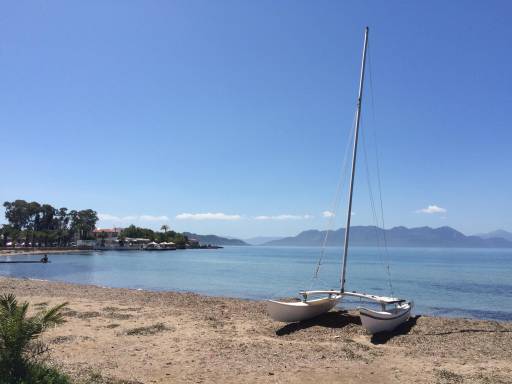
What is a trip to Greece without some time on the islands! On my last day I was determined to have some time on the sea, and chose Aegina (Αιγινα) as it’s the closest and most accessible island to travel to from Athens. Aegina is well-known for its pistachio farms and ouzo distilleries, and it’s just a quick 40-minute ferry ride on the high-speed catamarans which run regular services each way throughout the day. The ferries depart from Port Piraeus, which was only about a 40-minute journey by metro from my apartment.
Arriving into Aegina was like landing in Athens all over again: where was I supposed to go, what was I supposed to do? There is one highly recommended attraction on the island—the Temple of Aphaia, which dates back to 500 BC. I didn’t plan to go there though as I didn’t really have time to go to the other side of the island and frankly, I had seen enough crumbling temples by this point. With only two hours to spend before my ferry back, I opted to get lunch and just have a nice walk around the marina.
The marina of Aegina is lined with restaurants and cafes that look purpose-built for tourists, complete with the English signs advertising souvlaki and moussaka. Dubious of these, I did a quick search online to find a good place to eat, but found it closed and abandoned—another probable victim of the failing Greek economy. Starving, I settled for some olives, tomatoes, and bread I found in local-looking shops and took a nice, homemade lunch on a bench facing the sea.
Stomach full, I did a bit more aimless wandering and came across another archeological site and museum (great!), home to another ancient temple dedicated to the god Apollo. Although the visit was really just a way to pass the time (with not much else seeming to be going on around the town), I was pleasantly surprised to find a truly different presentation of ancient ruins here. While the museum was unimpressive and the descriptive signs did not offer much clarity, this was the only site where it was possible to walk and climb and jump all around the actual ruins; being the only person on the whole site and museum I found this to be quite fun! The ruins also had a great view overlooking the turquoise and sapphire patterned sea.
Having squeezed as much as possible out of this site visit, I went to walk back through the town again and came across a great shop called Mourtzis (Μουρτζησ) which sells nuts, spices, teas, and desserts, and specializes in their home-grown pistachios. The baklava and kataifi desserts I tasted here were some of the best I’ve ever had, with a perfect balance of nuts, cinnamon, and sugary syrup. Their bergamot-flavored loukoumi (the Greek version of Turkish delight) was also a sweet I had to try more than once. While stocking up with edible souvenirs to take home I got some advice from one of the family members who runs the shop about where I might have a try of the famous Aegina ouzo. He pointed me to a little café/bar just a few steps away.
The little bar sat right on the marina and blended in line with the touristy restaurants; if it hadn’t been pointed out specifically, I might not have even noticed it was different from its neighbor. But once I stepped inside I saw that this truly was as old-school and local as you might find; one of the people in the bar even had to translate for me when I tried to order a quick ouzo to try. Ouzo is a Greek aperitif with an anise flavor and not being a big fan of licorice, to be honest I didn’t think I would like it. My translator friend made sure I tried it the way a Greek person would have it—served on ice with some water and mezedes (small nibbles) on the side. I was surprised to find that it was actually quite enjoyable.
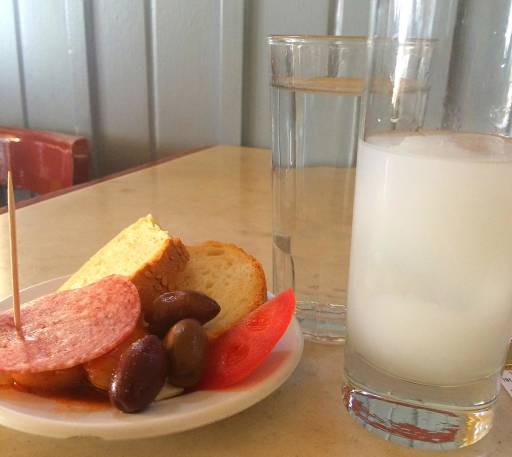
Sitting on a marina in stodgy old bar sipping ouzo and eating olives watching people walk by—what a way to end my time in Greece! With this moment passed it was time to head back to the dock to catch a ferry back to the mainland, and from there, back to the airport to head home. My quick 4-day visit had come to a close.
Final Impressions of Athens
Planning this trip to Athens, I had hoped to see the great archeological sites from ancient Greece which I had learned about from a young age. In this respect the city did not disappoint, and had I had a refresher in the ancient tales, I can imagine that my appreciation of the antiquities might be even greater. Otherwise I expected very little, and had had plenty of warnings about the worst: crappy architecture, run-down buildings, graffiti, pickpockets, and maybe even a riot thrown in with some political demonstrations. In my opinion, none of these impressions were an accurate representation of the city. Were there disappointments and frustrations? Absolutely. For a country whose economy relies so heavily on tourism, there is a lot to be done to offer visitors an intuitive way to get the best out of their time there. And how a city that has been so advanced for centuries has not figured out a way to implement a sewer system that can accept toilet paper is beyond me; honestly, the airplane I flew on to get there had a more advanced waste system, and this is definitely something they don’t mention in the guidebooks! But despite these hindrances Athens is a lively, eager city with lots more to offer than its ancient ruins and Greek salads. If you come to Athens looking to be impressed by what your eyes can see, you might leave disappointed. But with and open mind and heart to find the beauty of the city, you’ll find it’s all around you in unexpected places.
